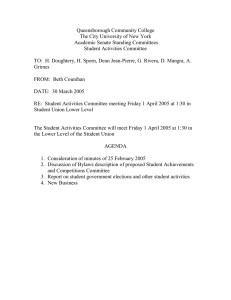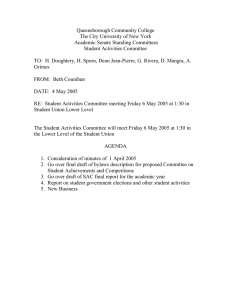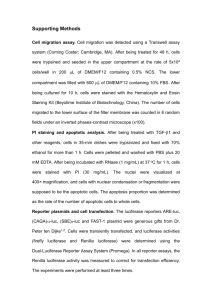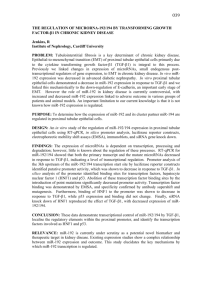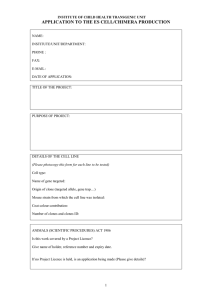Recombinant expression of human transforming ... isoforms in Chinese hamster ovary cells
advertisement
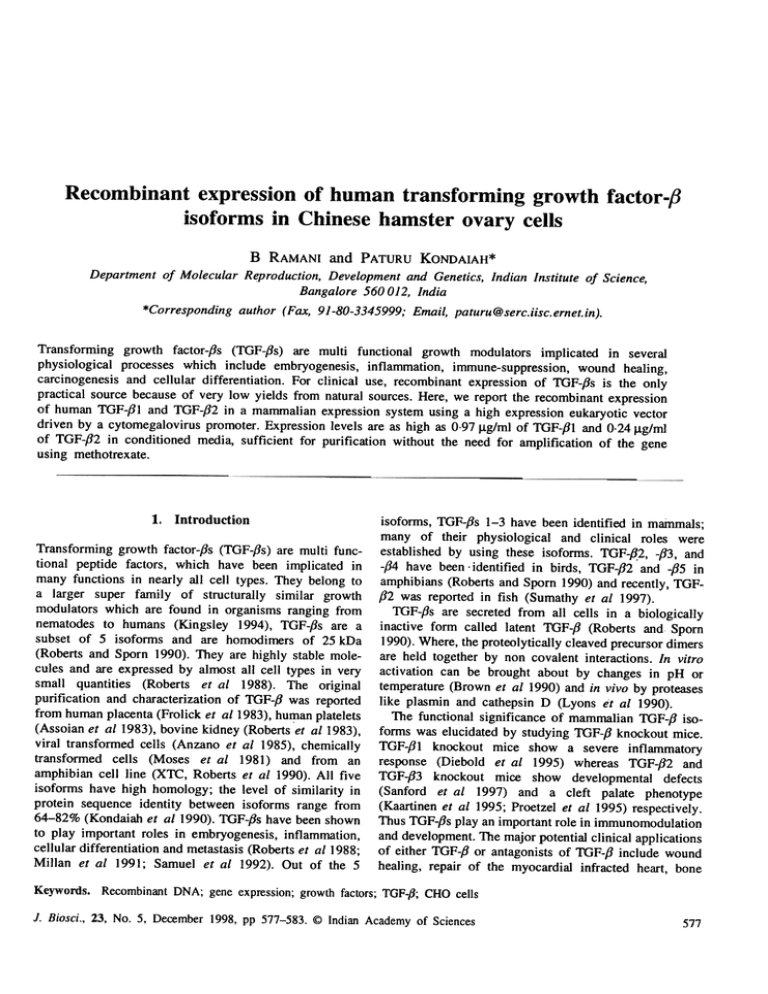
1.
Recombinant expression of human transforming growth factor-{3
isoforms in Chinese hamster ovary cells
B RAMANI and PATURU KONDAIAH*
Department of Molecular Reproduction,Developmentand Genetics,Indian Institute of Science,
Bangalore 560012, India
*Corresponding author (Fax, 91-80-3345999; Email, paturu@serc.iisc.ernet.in).
Transforming growth factor-ps (TGF-ps) are multi functional growth modulators implicated in several
physiological processes which include embryogenesis,inflammation, immune-suppression,wound healing,
carcinogenesisand cellular differentiation. For clinical use, recombinant expression of TGF-ps is the only
practical source becauseof very low yields from natural sources.Here, we report the recombinantexpression
of human TGF-pl and TGF-p2 in a mammalian expressionsystemusing a high expressioneukaryotic vector
driven by a cytomegalovirus promoter. Expressionlevels are as high as 0.97 flg/ml of TGF-pl and 0.24 flg/ml
of TGF-p2 in conditioned media, sufficient for purification without the need for amplification of the gene
using methotrexate.
Introduction
isoforms, TGF-ps 1-3 have beenidentified in mainmals;
many of their physiological and clinical roles were
Transforming growth factor-fJs (TGF-fJs)are multi func- established by using these isoforms. TGF-p2, -P3, and
tional peptide factors, which have been implicated in -p4 have been.identified in birds, TGF-p2 and -ps in
many functions in nearly all cell types. They belong to amphibians(Robertsand Sporn 1990)and recently, TGFa larger super family of structurally similar growth p2 was reported in fish (Sumathy et al 1997).
modulators which are found in organisms ranging from
TGF-ps are secreted from all cells in a biologically
nematodes to humans (Kingsley 1994), TGF-fJs are a inactive form called latent TGF-p (Roberts and Sporn
subset of 5 isoforms and are homodimers of 25 kDa 1990). Where,the proteolytically cleavedprecursordimers
(Roberts and Sporn 1990). They are highly stable mole- are held together by non covalent interactions. In vitro
cules and are expressedby almost all cell types in very activation can be brought about by changes in pH or
small quantities (Roberts et at 1988). The original temperature(Brown et al 1990) and in vivo by proteases
purification and characterizationof TGF-fJ was reported like plasmin and cathepsinD (Lyons et al 1990).
from humanplacenta(Frolick et at 1983),humanplatelets
The functional significance of mammalian TGF-p iso(Assoian et alI983), bovine kidney (Roberts et alI983),
forms was elucidatedby studying TGF-p knockout mice.
viral transformed cells (Anzano et al 1985), chemically TGF-p1 knockout mice show a severe inflammatory
transformed cells (Moses et al 1981) and from an response (Diebold et al 1995) whereas TGF-p2 and
amphibian cell line (XTC, Roberts et at 1990). All five TGF-p3 knockout mice show developmental defects
isoforms have high homology; the level of similarity in (Sanford et al 1997) and a cleft palate phenotype
protein sequence identity between isoforms range from (Kaartinen et al 1995; Proetzel et al 1995) respectively.
64-82% (Kondaiah et alI990). TGF-fJshave been shown Thus TGF-ps play an importantrole in irnmunomodulation
to play important roles in embryogenesis,inflammation, and development.The major potential clinical applications
cellular differentiation and metastasis(Roberts et al1988;
of either TGF-p or antagonistsof TGF-p include wound
Millan et al 1991; Samuel et al 1992). Out of the 5 healing, repair of the myocardial infracted heart, bone
Keywords.
RecombinantDNA; gene expression; growth factors; TGF-P; CHO cells
J. Biosci., 23, No.5, December 1998, pp 577-583. @ Indian Academy of Sciences
577
2.
578
B Ramani and Paturu Kondaiah
remodeling and immune suppression(Sporn and Roberts
1989). In view of the potential in vivo clinical application
of TGF-fJs, recombinant expressionof TGF-fJ isoforms
has been attempted by severalgroups in the past (Gentry
et al 1987; Bourdrel et al 1993; Graycar et al 1989;
Madisen et al 1989). However, due to the structural
complexity of TGF-fJs, only mammalian expressionsystems resulted in successfulexpressionof TGF-fJisoforms
that mimic natural TGF-fJs.In the above studies,TGF-fJs
were expressed in combination with various promoters
in mammalian expressionsystems and reasonablelevels
of expressionwere possible only after using methotrexate
for amplification of the constructs in the cells. Here, we
report recombinant expression of TGF-fJ isoforms in
CHO cells without the need for methotrexateamplification.
Expressionlevels are sufficient for further purification to
yield small amountsof TGF-fJ for both basic researchand
applied use.
2. Materials and methods
Construction
of TGF-fJ expression vector
enzymes (depicted on the primer sequencesin table 1)
and subcloned into the expression vectors. The cytomegalovirus (CMV) promoter was used to drive
expression of TGF-fJ1 and TGF-fJ2 using pRC/CMV
(TGF-fJ1) and pCDNA3 (WF-fJ2) vectors (Invitrogen,
USA). These vectors have a neomycin resistance gene
underthe control of the SV40 promoter, which facilitates
selectionof recombinantclones using G418. After ligation, the recombinantswere identified by colony hybridization followed by mini preparations of the plasmids
and were confirmed by sequenceanalysis. Large scale
plasmid DNAs from the positive clones were prepared
for transfectionusing Qiagen plasmid isolation columns
(Qiagen GmBH, Germany).
2.2
Cell cultures
All cell culture reagents were from Life Technologies,
USA. The disposableplasticware to grow cells was from
GreinerGmbH and Nunc Inc., Germanyand from Tarson,
Calcutta.Chinesehamsterovary (CHD) cells were grown
in Dulbecco's Modified Eagle's Medium (DMEM) supplementedwith 10% fetal bovine serum(FBS). Penicillin
and streptomycin were used at concentrations of
100 units/ml and 100~g/rnl, respectively. DMEM-Ham's
Fl2 (1 : 1) medium with out serum was used to collect
the condition medium from the CHD cell transfectants.
G418 was used for the selection of neomycin resistant
clones.
The TGF-P isofonns were amplified by polymerasechain
reaction (PCR) using specific oligonucleotide primers
designed to generatespecific restriction sites compatible
with the expressionvectors. Oligonucleotideprimers used
to amplify TGF-pl and TGF-P2coding regions are shown
in table I. The PCR amplifications were perfonned using
cDNA obtained from a human breastcarcinoma cell line,
MCF7. cDNA equivalent to 1 J.lgof total RNA was used
as template in a standard PCR reaction of 35 cycles
2.3 Transfectionof expressionconstructsinto
with 1 min denaturing at 95°C followed by annealing mammaliancells and selection of hyperexpressionclones
for I min at 58°C and extension at 72°C for 3 min.
Amplified products of 1.19 kb and 1.25 kb representing The plasmid DNA was introduced into CHO cells by
TGF-pl and -/:12coding regions were obtained (data not calcium phosphatemediated transfection (Gorman et at
shown). The products were digested with the respective 1982). This cell line was chosen based on its low
Table 1. Oligonucleotide primers used for the amplification of human TGF-fJI and
-fJ2 coding regions.
TGF-fJI
HindlIl
Reverse:5'ACGTCf AGATCAGcrGCAcrrGCAGGAGCG3'
XbaI
Forward: 5'AACTGAA 1TCATGGACf ACTGTGTGCTGAGC3'
TGF-{J2
BamHI
Reverse: 5'CCGACTCGAGTCAGCf ACAT1TACAAGACfT3'
XhoI
TGF-{Jl sequenceswere from Derynck et al (1985) and TGF-{J2sequenceswere from
de Martin et al (1987). The translationalstart codon "A TG" and the stop codon "TCA"
(complimentary),are representedin bold. The restriction enzyme cleavagesi.es flanking
the sequencesare underlined.
3.
Recombinantexpression of TGF-p
579
endogenousexpressionof TGF-{Jsand the ability of the for 2h. The cells were washed, fixed and solubilized
cells to stay alive in serum free cultures proves that and radioactivity measured in a scintillation counter.
facilitate isolation of more secreted proteins from the TGF-p was e'stimatedby using a standardcurve prepared
media. Transfections were performed using 2 j.tg and simultaneouslyby using the same procedure.
5 j.tg of super-coiledplasmid DNA. After 48 h post-transfection, cells were placed in selection media containing
2.6 RNA extraction and hybridization
1-2 j.tg/ml G418. After the elimination of cells which
do not contain the expression plasmid, G418 resistant
Total RNA was extracted from CHO cells using one-step
clones were individually isolated using sterile glass clonal
purification by guanidium isothiocyanate (Chomczynski
rings (Bellco Inc., USA) and were transferredto 24 well and Sacchi 1987) and the RNA concentration was
culture plates.
determined by measuringabsorbanceat 260 nm. Ten ~g
of total RNA was analysedon a 1% agarose-formaldehyde
2.4 Collection of conditioned media and TGF-fJ
gel and blotted onto a Hybond-N nylon membrane(Amersham, UK). Prehybridization and hybridization were
assays
carried out at 65°C in a buffer containing 1% bovine
The clones were expanded and were plated individually serum albumin, 7% SDS, 1 roM EDTA and 0.5 M
for collection of conditioned media and were also frozen disodium hydrogen phosphate (pH 7.0) (Church and
for subsequentuse. The cells were seeded in 24 well Gilbert 1984). The probes were labelled with r2p]dCTP
clusters for the isolation of conditioned media and were (NEN Life Sci, USA) by the random primed method
allowed to grow for two days in DMEM supplemented using the megaprime labelling kit (Amersham, UK).
with 10% fetal bovine serum and antibiotics. After the Hybridizations were carried out for about 16 h and the
cells reached confluence, they were washed with serum blots were washed with 2 x SSC at room temperature
free DMEM thrice for 1-2 h each. Finally, 0.5 ml of for 30 min and for another 30 min with 0.2 x SSC at
serum free medium was added to each clone and the 65°C and exposed to Hyperfilm (Amersham, UK) at
medium was collected after 20-24 h. Media wer~cen- -70°C.
trifuged at 10,000g to remove debris and supernatants
were frozen at -20°C until further processing.
2.7 Westernblot analysis of TGF-fJl
An aliquot of the conditioned medium from eachclone
was activated by heating at 80°C for 15 min and kept Conditioned mediumfrom TGF-pl transfectedCHO cells
on ice prior to assay.This treatmentreleasesthe bioactive \Vas subjected to Western blot analysis. Samples were
TGF-p from the latent complex. Serial dilutions of con- electrophoresedon 15% SDS-PAGE, transferred to a
ditioned media containing activated TGF-{:Jwere assayed PVDF (Amersham, UK) membrane and blocked with
by CCL64 (obtained from American Type Culture Col- NET buffer (150 mM NaCI, 0.005 mM EDTA at pH 8.0,
lection, Maryland, USA) cell growth inhibition assayto 50mM Tri$ HCI, pH 7.5, 2% BSA, 0.05% Triton X-100).
estimate biological activity in the samples.
The blot was incubated overnight at 4QC with 10 I.1g/ml
of primary antibody, which is a polyclonal antibody
rai$ed against amino acid 1-30 of the mature TGF-pl
protein (Flanders et al 1989). The blot was washed
extensive.lyin 1 x PBS and 0..1% Tween 20 and subThis is a bioassay designed to detect TGF-fJ in the sequently incubated f()r 1 h at room temperature with
samples and is highly sensitive in the range of 25- goat anti,rabbit HRP conjugate according to manufac200 pg/ml of the TGF-fJs (Danielpour et at 1989). It is turer's in$tructions (Amersham Life Science). Immunobased on an important property of TGF-fJ, namely the detection of TGP-pl protein was by chemilumini$cence
growth inhibition of epithelial cells. Although this assay (ECL sY$tem,Amersham, UK).
does not distinguish between the isoforms, one can
estimate 1he level of each isoform by using isoform
Results
specific neutralizing antibodies. Briefly about 2.5 x 105
cells were seeded in 24 well plates in assay buffer The clones were isolated after transfection and selection
(DMEM with 0.2% FBS). After the cells attached (after for about two weeks in 1 ~g/ml of G4I8 containing
about 2 h), the samples containing TGF-fJ with and media. A total of 48 clones transfected with the TGFwithout antibodies (if specific isoform is assayed)were fJI construct were isolated and the conditioned medium
added and the cells were allowed to grow for 18-22 h. from eachclone was assayedby using a TGF-fJI specific
To monitor growth inhibition, 0.5 ~Ci of [3H]thymidine immunoassay(Quantakine system, Rand D Systems,
(sp. act. of "10-90Ci/mM, NEN Life Sci. Products,USA) USA). Initially, pairs of TGF-fJI clones were tested for
was added to each well and DNA synthesis permitted their ability to synthesizethe protein (data not shown).
2.5 CCL64 mink lung epithelial cell growth
inhibition assay
4.
3
Bold
350
580
B Ramani and Paturu Kondaiah
The basal level of TGF-pl secreted by CHO cells
transfected with vector alone (control) was approximately
3.5 ng/ml; prelinl.inary results indicate that some of the
expressingclones result in greater than 40 ng of protein
being secreted per ml of conditioned medium. Based on
the preliminary results from the Quantakine assay,conditioned media from 4 individual clones were tested by
CCL64 assay (table 2). As shown in table 2, two
individual TGF-pl clones, TGF-f31-2 and TGF-pl-24
expressed 120 and 350 ng/ml respectively of TGF-pl
protein in the conditioned medium. Conditioned media
collected from 69 TGF-p2 transfectedclones were tested
for TGF-p2 expression levels (data not shown) and 12
clones expressedgreaterthan 80 ng/ml TGF-p2 (table 2).
One TGF-p2 clones (clone 49), which showed 120ng/
ml/day expression, was selected for further characterization. In order to assessthe sustainedproduction of
the recombination protein from these clones, the TGFpl-24 and TGF-p2-49 clones were cultured for 3 days
in serum free medium and the TGF-p secreted in the
conditioned medium was estimated to be approximately
970 ng/ml for TGF-pl-24 and 244 ng/ml for TGF-p2-49
clone (table 3). This higher level of expressionin 3 day
collection correlated well with the production in one day
by the respective clones.
As the amount of TGF-pl produced by the TGF-pl-2
and TGF-pl-24 clones was considerable,they were further
characterized by RNA analysis. Northern blot analysis
revealed two specific transcripts of 1.5 kb and 3.5 kb
(figure 1). There was a high ..level of mRNA that was
specific to the construct that was transfected (1.5 kb
message) in cloneTGF-p1':'24 and' 'th'e'mRNA corite,nt
was correlated with the level of protein expressionfrom
these clones. The higher molecular weight mRNA of
Table 2. Expressionlevels of bioactive TGF-fJ in each clone as assayed
by CCL64 assay.
TGF-fJl.
TGF-fJ2
ng/ml
80
100
90
90
95
85
100
80
120
90
80
91
3.5 kb appearsto be an mRNA transcribed by the CMV
promoter that includes both the TGF-{JI coding region
and the coding region of the downstream neomycin
resistancegene.The size correspondswell with the fused
mRNA that utilizes the polyadenylation site of the neomycin resistance gene. RNA from vector transfected
CHO cells or TGF-{J1-8 and 9 clones (figure 1, lanes
1, 2 and 3) did not show any detectableTGF-{JI transcript,
again correlating well with the low levels of the protein
expressedby these clones.
To further confirm the ide:ntity of recombinant bioactive TGF-{JI in the conditioned medium, Western blot
analysiswas performed (figure 2). A polyclonal antibody
raised against amino acids 1-30 of the mature TGF-{JI
protein (Flanders et al 1989) was used. As is evident
from figure 2, a single protein band of size 12.5kDa
was identified in the conditioned medium of clone TGF{J1-24.Recombinanthuman TGF-{JI protein (a gift from
Dr Anita Roberts)was used asa standardand an identical
band obtained in the clone confirmed that a processed
mature TGF-{JI protein was present in the conditioned
medium. The claim, that the secreted factor from clone
24 is TGF-{JI is based on other findings as well; for
exampl,e,the observationthat clones transfected with the
control,vectordo not expressrecombinantRNA (figure 1).
As TGF-{J1-24clone expressesconsiderable amounts
of the protein, this clone will be used for the large-scale
purification of the recombinant, fully processedprotein.
Purification will be achieved using gel filtration, ion
exchange chromatographyand HPLC.
Discussion
Recombinant expressionof peptide factors has become
a powerful tool for a variety of applications ranging
from basicTesearchto humantherapy. Severalexpression
systems for the large-scale produetion of proteins have
been developed over the last two decades, with the
choice of the systemdependingon the natureand potential
application of the specific protein. For example, if the
protein does not have any complex structural constrains,
one can use a simple and inexpensive prokaryotic
expression system using Escherichia coli as the host.
The disadvantagein using a prokaryotic system for the
expression of mammalian proteins is improper folding
and lack of glycosylation in these systems.Some features
of eukaryotic expressioncould be achieved in yeast and
Table 3. TGF-fJ protein levels in the conditioned
media of selected cloneSas estimated by CCL64
assayto assessthe sustained level of production.
Clone No.
letters indicate the clones from each
TGF-{JI clone 24
group selected for further expansionandcharacterization.
TGF-{J2 clone 49
day
ng/ml
120 ng/ml
day
972 ng/ml
244 ng/ml
581
Recombinantexpression of TGF-p
1
2
49kd
28 kd
28S
3.5 k b
18S
18kd
14kd
1.5 k b
Figure 1. Northern blot analysis using TGF-fJI probe. Lane
1, RNA from vector transfected clone (10 ~g); lane 2, TGFfJl-9 (IO~g); lane 3, TGF-fJl-8 (IO~g); lane 4, TGF-fJI-2
(20~g); lane 5, TGF-fJI-2 (IO~g); lane 6, TGF-fJl-24 (IO~g).
8 kd
TGF-BI
Figure 2. Western blot analysis of conditioned media from
clone TGF-fJI-24. Lane 1, 15 III of TGF-fJI-24 conditioned
media from one day collection; lane 2, 20 ng of TGF-fJI
Standard(R and D systems,USA).
baculovirus expressionsystems.The yeastSaccharomyces
expressionsystems,but expressionlevels were extremely
cervisiae and more recently, Pichia pastoris have been low (in the range of 10~20ng/ml of conditioned medium)
used to express and purify recombinant humanproteins. and hence the method was not viable (Gleizes et al
The above systems have the combined advantage of
1996).
producing large quantities and preserving the bioactivity
TGF-{3 has been purified from the human platelets,
of the respective protein, but a probl~m encountered which are a major natural sourceof the protein (Assoian
while using the yeast expression systems is over et al 1983). However, the yield obtained was much less
mannosylation of the protein. However, there are some when compared to that obtained using the mammalian
proteins with high structural complexity and to produce
expressionsystem. TGF-{31has been expressedin CHO
them in a bioactive form, one has to depend on cells using vectors with the SV40 early promoter after
mammalian expression systems; these can be used to
gene amplification using methotrexate (Gentry et al
get a fully processed,glycosylated and biologically active
1987). TGF-{32 expression has been achieved in the
protein. Several growth factors, hormones,r~ceptors,and mammalian expression system using the CHO cell line
transcription factors have been successfully expressed expressingthe hybrid TGF-{3-1(NHJ/beta-2 (COOH) conusing mammalian expression systems. Hence the mam- struct (Madisen et al 1989). Investigators have also
malian expressionsystems offer a number of advantages reported the recombinant expressionand purification of
over the above mentioned systems.
TGF-{33 in a mammalian system (Graycar et al 1989).
Severalinvestigatorsincluding ourselveshaveattempted However, all the above systems have used expression
expression of TGF-p proteins in E. coli. The approaches
strategiesusing methotrexateand dihydro folate reductase
were either to express full-length TGF-{J precursor or deficient CHO (dhfr- CHO) cells for isolation and further
only the maturel12 amino acid single chain. The full
purification of TGF-{3s.One disadvantagein using dhfr
length precursor did not yield any noticeable expression, amplification is the requirement of using mutant CHO
possibly due,tp proteolytic degradationof the protein or cells deficient in dhfr enzyme. In addition, the large
inappropriate codon psage. When the mature region of amount of methotrexaterequired for amplification of the
the cDNA 'was used, although protein expressionwas plasmids in the cells makes it prohibitively expensive.
feasible in E. coli, the protein could not be folded and Our results demonstrate the feasibility of expressing
dimerized. Recombinant
expressionof TGF-{JI was also TGF-{3s without the need for dhfr- CHO cells and
",.. .
attempted In Sf9 (insect) cells using a baculovirus methotrexateamplification. In addition, the secretedpro-t~ins
expression syst~m. A functional, mature TGF-{JI was
were found to be biologically active. The higher
present in the conditioned medium, as in mammalian levels of TGF-{31 expression obtained by us without
582
B Ramani and Paturu Kondaiah
amplification of the plasmid appears to be due to the
combined use of a powerful eukaryotic promoter, the
cytomegalovirus early promoter, and altering the culture
conditions (high density culturing of the cells in smaller
quantities of the serum free medium). This allows the
concentrationof the secretedproteins. TGF-fJwas found
to be a very stable protein, not easily degraded, the
secretedproteins might have retained activity over time.
It is possible to improve the yields by culturing the
cells for longer perio.ds; CHO cells can be maintained
in serum free conditions for as long as 5 days with out
much loss of cells (P Kondaiah, personal observation).
Although our expression system yields (2-3-fold) lower
levels than attainable by amplified expression, one can
improve by manipulating the culture conditions. Moreover, the method can be used for the recombinant
expression of any other bio-active protein which needs
complex post translational processing of modifications.
Derynck R, Jan-ettJ A, Chen E Y, Eaton D H. Bell J R,
Assoian R K, Roberts A B. Sporn M B and Goeddel D V
1985 Human transforming growth factor-betacomplementary
DNA sequenceand expression in normal and transformed
cells; Nature (London) 316 701-705
Diebold R J, Eis M J, Yin M, Ormsby I, Boivin G P, Darrow
B J, Saffitz J E and DoetschmanT 1995 Early-onsetmultifocal
inflammationin the transforming growth factor-f31null mouse
is lymphocyte mediated; Proc. Natl. Acad. Sci. USA 92
12215-12219
FlandersK C, ThompsonN L. Cissel D, van Obberghen-Schilling
E, Baker C C. Kass M E, Ellingsworth L, Roberts A B and
Sporn M B 1989Transforminggrowth factor-pI: Histochemical
localization with antibodiesto different epitopes; J. Cell Bioi.
108 653-660
Frolik C A, Dart L L, Meyers C A. Smith D M and Sporn
M B 1983 Purification and initial characterizationof a type
beta transforming growth factor from human placenta; Proc.
Natl. Acad. Sci. USA 80 3676-3680
Gentry L E, Webb N R, Lim G J, Brunner A M. Ranchalis
J E, Twardzik D R, Lioubin M N, Marquardt Hand Purchio
A F 1987Type 1 transforming growth factor beta: amplified
expressionand secretionof mature and precursorpolypeptides
in Chinesehamsterovary cells; Mol. Cell. Bioi. 7 3418-3427
Acknowledgements
Gleizes P E, Beavis R C, Mazzieri R, Shen B and Rifkin D B
1996 Identification and characterizationof an eight cysteine
Authors are grateful to Drs Anita Roberts and K C
repeat of the latent transforming growth factor-betabinding
protein-l t!lat mediates bonding to the latent transforming
Flanders (NIH, USA) for providing standardTGF-{J and
growth factor-betal; J. Bioi. Chern.271 29891-29896
anti-TGF-{J antibodies, Dr S K Sikdar (IISc, Bangalore)
for CHO cells and Ms K; V Desai for the help with GormanC M, Merlino T, Willingham M C, PastanI and Howard
B H 1982 The Rous sarcomavirus long terminal repeatis a
Western blot analysis. This work was supported by a
strong promoter when introduced into a variety of eukaryotic
grant from the Departmentof Biotechnology, New Delhi.
cells by DNA-mediated transfection; Proc. Natl. Acad. Sci.
USA 79 6777-6781
Graycar J L, Miller D A, Arrick B A, Lyons R M, Moses H L
References
and Derynck R 1989 HumanTransforming growth factor-f33:
RecombinantExpression,purification, and Biological activities
in comparisonwith transforming growth factors-f31and -f32;
Anzano M A, Roberts A B, De Larco J E, Wakefield L M,
Mol. Endocrinol. 3 1977-19~6
Assoian R K, Roche N S, Smith J M, Lazarus J E and Sporn
M B 1985 Increasedsecretionof type,8 transforming growth Kaartinen V, Voncken J W, Shuler C, Warburton D, Bu D,
HeisterkampN and Groffen J 1995Abnormallung development
factor accompaniesviral transformation of cells; Mol. Cell.
and cleft palate in mice lacking TGF-f33indicates defects of
Biol. 5 242-247
epithelial-mesenchymal
interaction; Nature Genet.11 415-421
Assoian R K, I<omoriya A, Meyers C A, Miller D M and Sporn
M B 1983Transforming growth factor-betain humanplatelets; Kingsley D M 1994 The TGF-betasuperfamily: new members,
new receptors,and new genetic tests of function in different
J. Biol. Chern. 258 7155-7160
organisms;GenesDev. 8 133-146
Bourdrel L, Lin C H, Lauren S L, Elmore R H, SugarmanB J,
Hu S and WestcottK R 1993 Recombinanthumantransforming Kondaiah P, Sands M J, Smith J M, Fields A, Roberts A B,
Sporn M B and Melton D A 1990 Identification of a novel
growth factor-beta1: expressionby Chinesehamsterovary cells,
transforminggrowth factor-beta(TGF-P5) mRNA in Xenopus
isolation,and characterization;Protein Exp. Purif 4 130-140
iaevis; J. BioI. Chern. 265 1089-1093
Brown P D, Wakefield L M, Levinson A D, Sporn M B 1990
Physico-chemicalactivation of recombinantlatenttransforming Lyons R M, Gentry L E, Purchio A F and Moses H L 1990
Mechanismof activation of latent recombinanttransforming
growth factor-,8s 1, 2, and 3; Growth Factors 3 35-43
growth factor-pI by plasmin; J. Cell. Bioi. 110 1361-1367
Chomczynski P and Sacchi N 1987 Single-stepmethod of RNA
isolation by acid guanidinium thiocyante-phenol-cholorofrQm Madisen L, Farrand A L, Lioubin M N, Marzowski J, Knox
L B, Webb N R, Lim J and Purichio A F 1989 Expression
extr~tion; Anal. Biochern. 162 156-159
and characterizationof recombinantTGF-b2 proteins produced
Church G M and Gilbert W 1984 Genomic sequencing;Proc.
in mammaliancells; DNA 8 205-212
Natl. Acad. Sci. USA 81 1991-1995
Danielpour D, Dart L L, Flanders K C, Roberts A B and Sporn Millan F A, Denhez F, Kondaiah P and Akhurst R J 1991
Embryonic gene expressionpatterns of TGF beta I, beta 2
M B 1989 Immunodetectionand quantitationof the two forms
and beta 3 suggestdifferent developmentalfunctions in vivo;
of transforming growth factor-beta (TGF-{31 and TGF-,82)
Development 111 131-143
secretedby cells; J. Cell. Physiol. 138 79-86
de Martin R, HaendlerB, Hofer-WarbinekR, GaugitshH, Wrann Moses H L, Branum E L, ProperJ A and RobinsonR A 1981
Transforming Growth Factor production by chemically transM, SchlusenerH, Seifert J M, Bodmer S, FontanaA and Hofer
E 1987 ComplementaryDNA for human glioblastoma-derived formed cells; Cancer Res. 4 2842-2848
T cell suppressorfactor, a novel member of the transforming ProetzelG, Pawlowski S A, Wiles M V, Yin M, Boivin G P,
Howles P N, Ding J, Ferguson M W J and DoetshmanT
growth factor-{3gene family; EMBO. J. 6 3673-3677
Recombinantexpression of TGF-fJ
1995Transforming growth factor-{J3is required for secondary
palate fusion; Nature Genet. 11 409-414
Qian S W, Kondaiah P, Roberts A B and Sporn M B 1990
cDNA cloning by PCR of rat transforming growth factor
beta-I; Nucleic Acids Res. 18 3059
Roberts A B and Sporn M B (eds) 1990 The transforming
growth factor-fJs;in Peptidegrowthfactors and their receptors
(I) Handbook of experimentalpharmacology95/1(Heidelberg:
Springer-Verlag)pp 419-472
Roberts A B, Anzano M A, Meyers C A, Wideman J, Blacher
R, Pan Y -C, Stein S, Lehrman S R, Smith J M, Lamb L C
and Sporn M B 1983 Purification and properties of a type
betatransforming growth factor from bovine kidney; Biochemistry 22 5692-5698
Roberts A B, Flanders K C, Kondaiah P, Thompson N L, Van
Obberghen-SchillingE, Wakefield L, Rossi P, de Crombrugghe
B, Heine U and Sporn M B 1988 Transforming growth factor
beta: biochemistry and roles in embryogenesis,tissue repair
and remodeling,and carcinogenesis;RecentProg. Horm. Res.
44
157-197
Roberts A B, Rosa F, Roche N S, Coligan J E, Garfield M,
Rebbert M L, Kondaiah P, Danielpour D, Kehrl J H, Wahl
S M, Dawid I B and Sporn M B 1990 Isolation and Characterizationof TGF-p2 and TGF-{J5from mediumconditioned
by XenopusXTC cells; Growth Factors 2 135-147
SamuelS K, Hurta R A R, Kondaiah P, Khalil N, Turley E A,
Wright J A and GreenbergA H 1992 Autocrine induction of
tumor proteaseproductioninvasion by a metallothionein-regulated TGF-pl (Ser 223, 225); EMBO l. 11 1599-1605
Sanford L P, Ormsby I, Gittenberger-deGroot A C, Sariola H,
Friedman R, Boivin G P, Cardell ELand
Doetschman T
1997 TGF-p2 knockout mice have multiple developmental
defects that are non-overlappingwith other TGFp knockout
phenotypes;Development124 2659-2670
Sporn M B and Roberts A B 1989 Transforming Growth
Factor-beta.Multiple actionsand potential clinical applications;
lAMA 262 938-941
Sumathy K, Desai K V and Kondaiah P 1997 Isolation of
transforming Growth Factor-{J2cDNA from a fish, Cyprinus
carpio by RT-PCR; Gene 191 103-107
MS received 10 July 1998; accepted 13 October 1998
ColTesponding editor: SEYED E HASNAIN
583
